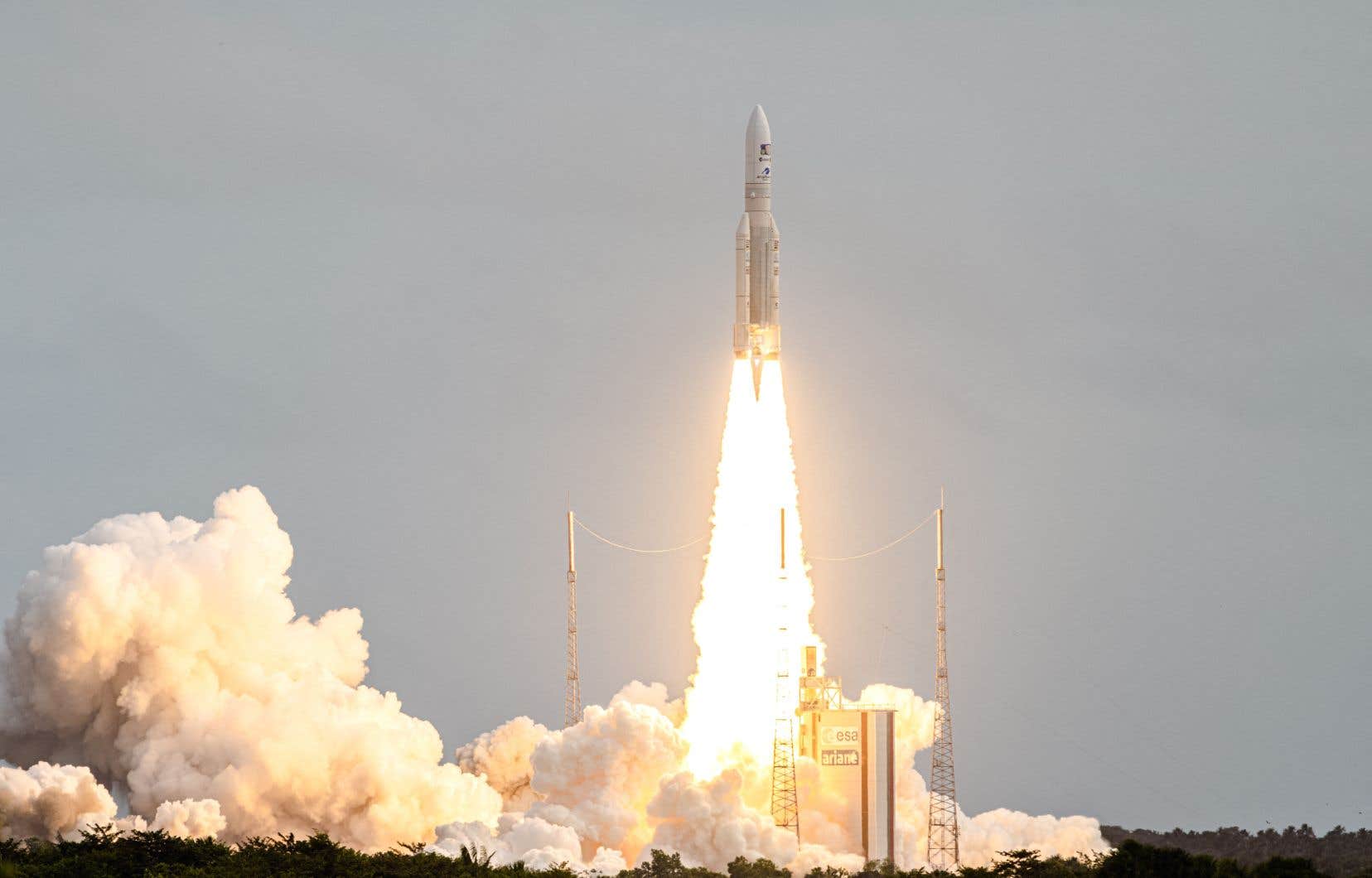The European space probe Juice was successfully launched Friday by an Ariane 5, on the second attempt, towards Jupiter and its icy moons in search of environments favorable to forms of extra-terrestrial life.
The rocket lifted off at 12:14 GMT (8:04 a.m. EDT) from Kourou spaceport in French Guiana, carrying the European Space Agency’s (ESA) flagship science mission in its fairing.
Thursday, the launch had to be postponed for 24 hours, at the last moment, due to the risk of thunderstorms.
As expected, the Juice probe (Jupiter Icy Moons Explorer) separated from the launcher 27 minutes after takeoff, at an altitude of about 1500 km. “The separation is successful,” the operations manager said from the Jupiter control room, to applause.
The many guests present, including the Belgian King Philippe, rushed to the terrace to see Ariane 5 take off above the Guyanese forest.
The Ariane 5 mission “is a success”, declared Stéphane Israël, president of Arianespace. “Best wishes to Juice for the incredible journey she is about to undertake! “, he added in a press release.
A few minutes after the separation, the teams announced that they had received a signal from the probe, much to their relief.
“Juice is the most complex probe ever sent to Jupiter,” said ESA Director General Josef Aschbacher.
“It’s an extraordinary mission which shows everything Europe is capable of”, welcomed Philippe Baptiste, the president of the National Center for Space Studies (CNES) which manages the Guiana Space Center, on the eve of the launch. .
Designed by Airbus, Juice carries ten scientific instruments (optical camera, imaging spectrometer, radar, altimeter, magnetometer, etc.). The probe is also equipped with huge solar panels of 85 m2 – the size of a basketball court – to keep power in an environment where sunlight is 25 times weaker than on Earth.
This is the first time that space Europe has gone to explore a planet in the outer solar system, which starts after Mars.
“In small steps, space exploration is pushing back the frontiers of knowledge”, welcomed AFP Thomas Pesquet, who attended the launch alongside French astronaut Claudie Haigneré and his German colleague Matthias Maurer. .
Cruise “not at all quiet”
“If we are in a position to return to the Moon in a few years it is because there were robotic precursors. Robotic and manned exploration are two arms of the same effort,” he argued.
Friday’s launch is only the prelude to a cruise that “will not be at all quiet”, commented Carole Larigauderie, head of the Juice project at CNES.
Juice should not reach its final destination, more than 620 million kilometers from Earth, until 2031. Unable to reach Jupiter directly, the machine will have to go through complex gravitational assistance maneuvers which consist in using the force attraction of other planets to gain speed.
By a flyby Moon-Earth first, then Venus (2025), then again Earth (2029), before taking its momentum towards the mastodon of the solar system and its largest moons, discovered by Galileo ago 400 years: Io the volcanic and its three frozen companions Europe, Ganymede and Callisto.
“The Jovian system has all the ingredients of a mini-solar system,” notes Carole Mundell, science director for ESA. Its exploration “will make it possible to study how our solar system works, and will try to answer the question “Are we alone in the Universe?” “, underlines the astrophysicist.
Juice’s main quest is to find not life directly, but environments for it to appear. If Jupiter, a gaseous planet, is uninhabitable, its moons Europa and Ganymede are ideal candidates: under their surface of ice, they shelter oceans of liquid water, yet only water in a liquid state makes life possible.
Juice targets Ganymede: in 2034, it should be placed in orbit around this natural satellite, the largest in the solar system and the only one to have a magnetic field protecting it from radiation.
Between two thick crusts of ice there moves a gigantic ocean, “deep several tens of kilometers, much deeper than the oceans on Earth”, underlined Josef Aschbacher.
The challenge of the mission is to know its composition, to deduce whether an ecosystem could develop there. “We know that on Earth, there is a subglacial lake (in Antarctica, editor’s note) where we found a kind of mucus which develops – therefore life”, decrypts Carole Larigauderie.
“If Juice can prove that Ganymede is habitable so that he can go and check that there is life in the future, that would be fabulous! “, she exalts herself.
The launch of Juice, at a cost of 1.6 billion euros, comes in the midst of a launcher crisis for Europe, almost deprived of autonomous access to space after the departure of Russian Soyuz rockets from Kourou, cumulative delays of Ariane 6 and the failure of the first commercial flight of Vega C.
Thursday’s flight is the penultimate of Ariane 5 before the first of Ariane 6 scheduled for the end of 2023.
